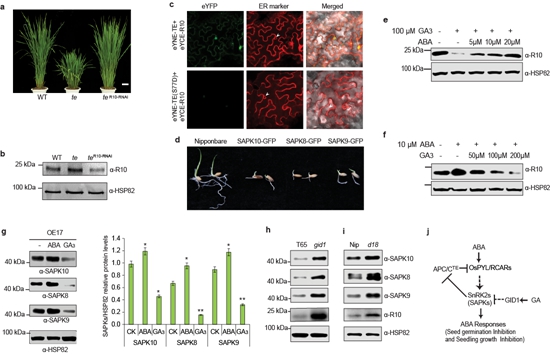分享到
Antagonism Mechanism of GA on ABA signaling pathway
ABA is a stress responsive phytohormone which inhibits seed germination and seedling growth to adapt to unfavorable environmental conditions while GA is a major growth promoting phytohormone which promotes seed germination, seedling growth, flowering and leaf expansion. Recent studies have portrayed a conceptual ABA signaling pathway in which ABA binds to its receptor PYL/PYR/RCARs, subsequently the PYL/PYR/RCAR-ABA complex binds to PP2C phosphatases which repress the SnRK2s, releasing the activated SnRK2s to phosphorylate downstream targets to activate ABA responses. In the GA signaling pathway, the receptor GID1 and E3 ligase SCFSLY1/GID2 together promote the degradation of the DELLA repressor proteins in a GA-dependent manner to relieve their repression of GA action. Although recent studies have shown that ABA can antagonize GA-promoted degradation of DELLA proteins, the regulatory mechanism underlying the antagonism of GA on ABA signaling pathway remains largely unknown.
Recently, the Innovation Team of Crop Functional Genomics from Institute of Crop Science (ICS) of Chinese Academy of Agricultural Sciences (CAAS) has made a progress in decoding the antagonism mechanism of GA on ABA signaling pathway.
In a previous study, they reported that rice Tiller Enhancer (TE) encodes an activator of the APC/CTE E3 ubiquitin ligase complex that acts to repress tillering (branching) by promoting the degradation of MOC1, a master regulator of plant architecture and tiller number. In addition to increased tillers, the te mutant also displays reduced height, twisted flag leaf and panicles, suggesting that TE regulates other developmental processes.

Recently, the Innovation Team of Crop Functional Genomics from Institute of Crop Science (ICS) of Chinese Academy of Agricultural Sciences (CAAS) has made a progress in decoding the antagonism mechanism of GA on ABA signaling pathway.
In a previous study, they reported that rice Tiller Enhancer (TE) encodes an activator of the APC/CTE E3 ubiquitin ligase complex that acts to repress tillering (branching) by promoting the degradation of MOC1, a master regulator of plant architecture and tiller number. In addition to increased tillers, the te mutant also displays reduced height, twisted flag leaf and panicles, suggesting that TE regulates other developmental processes.

In this study, they find that the loss-of-function te mutant displays increased sensitivity to ABA, but reduced sensitivity to GA. Further, they find that TE physically interacts with ABA receptor OsPYL/RCARs and promotes their degradation by the proteasome. Genetic analysis also shows OsPYL/RCARs act downstream of TE in mediating ABA responses. Conversely, ABA inhibits APC/CTE activity by phosphorylating TE through activating the SNF1-related protein kinases (SnRK2s), which may interrupt the interaction between TE and OsPYL/RCARs and subsequently stabilize OsPYL/RCARs. In contrast, GA can reduce the level of SnRK2s and may promote APC/CTE-mediated degradation of OsPYL/RCARs. Thus, their research displays that the SnRK2-APC/CTE regulatory module represents a regulatory hub underlying the antagonistic action of GA and ABA in plants.
This work establishes a base for further complete understanding on the antagonism mechanism of GA and ABA, which would shed a new light on the regulation mechanism of plant growth and development and contribute to crops improvement.
This work was supported by 973 National Basic Research Program (2014CB943403), National Transformation Science and Technology Program (2014ZX08001006), 863 National High-tech R&D Program of China (2012AA10A301, 2011AA10A101), National Natural Science Foundation (31201271, 31371601), Jiangsu Province 333 Program (BRA2012126).
This work has been published on Nature Communications on August 14th 2015 (DOI: 10.1038/ncomms8981). More details are available on the links bellow:
http://www.nature.com/ncomms/2015/150814/ncomms8981/full/ncomms8981.html
This work establishes a base for further complete understanding on the antagonism mechanism of GA and ABA, which would shed a new light on the regulation mechanism of plant growth and development and contribute to crops improvement.
This work was supported by 973 National Basic Research Program (2014CB943403), National Transformation Science and Technology Program (2014ZX08001006), 863 National High-tech R&D Program of China (2012AA10A301, 2011AA10A101), National Natural Science Foundation (31201271, 31371601), Jiangsu Province 333 Program (BRA2012126).
This work has been published on Nature Communications on August 14th 2015 (DOI: 10.1038/ncomms8981). More details are available on the links bellow:
http://www.nature.com/ncomms/2015/150814/ncomms8981/full/ncomms8981.html
Latest News
-
 Apr 18, 2024Opening Ceremony of the Training Workshop on Wheat Head Scab Resistance Breeding and Pest Control in Africa Held in CAAS
Apr 18, 2024Opening Ceremony of the Training Workshop on Wheat Head Scab Resistance Breeding and Pest Control in Africa Held in CAAS -
 Apr 03, 2024IPPCAAS Co-organized the Training Workshop on Management and Application of Biopesticides in Nepal
Apr 03, 2024IPPCAAS Co-organized the Training Workshop on Management and Application of Biopesticides in Nepal -
 Mar 28, 2024Delegation from the School of Agriculture and Food Science of University College Dublin, Ireland Visit to IAS, CAAS
Mar 28, 2024Delegation from the School of Agriculture and Food Science of University College Dublin, Ireland Visit to IAS, CAAS -
 Mar 25, 2024Director of World Food Prize Foundation visited GSCAAS
Mar 25, 2024Director of World Food Prize Foundation visited GSCAAS -
 Mar 20, 2024Institute of Crop Sciences (ICS) and Syngenta Group Global Seeds Advance Collaborative Research in the Seed Industry
Mar 20, 2024Institute of Crop Sciences (ICS) and Syngenta Group Global Seeds Advance Collaborative Research in the Seed Industry
